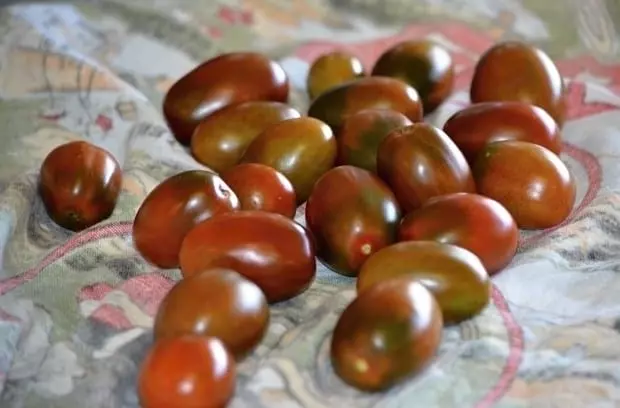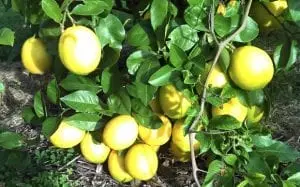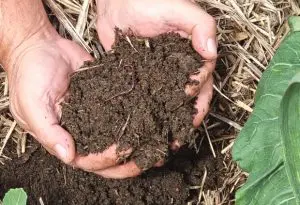This tomato variety is called the Black Plum. And, let me start by immediately stating how I completely misunderstood this tomato from the beginning (until I actually tasted it).
I grew this tomato through our winter here (subtropical climate) and although it's warmer than other places through winter where I am, tomatoes still can be tricky to grow. The hardest tomatoes to grow are the larger varieties so I like to back up those plants with several smaller varieties in our garden so if the big ones fail or (flower but don't fruit, which is common in the cold) I will at least still have tomatoes.

Black Plum Tomato (image above)
Lately, I've been trying in-between varieties of tomatoes which are nowhere near the size of the large ones but are still bigger than the small cherry types and the Black Plum is one of those kinds. I have to say from the outset that this tomato didn't disappoint and will become a regular in my garden as a great compromise between large and small.
As with all my tomato reviews in this series, I will summarise by giving the tomato variety a final rating score out of 10 points by averaging my rating scores for the tomato on the following criteria:
-
Size of Fruit vs Productivity
-
Taste & Meatiness (texture)
-
Disease and Pest Resistance
-
Growth
-
X-Factor
So, let's shake the sauce bottle and get moving!
Characteristics
The Black Plum tomato is a small sized indeterminate plant (continues to grow-on kind-of like a vine) with a thick leader and many long branching off-stems; therefore, it will need staking or support. Most indeterminate tomato plants grow quite big and keep sprawling but I found this plant to be less rigorous.
I like to use a trellis support structure of some sort and train the plant to the top then let it tumble naturally over. My trellises vary, sometimes I use a wire or steel mesh (like concrete reinforcing mesh) and other times I use the affordable plastic trellis material – all do a good job to hold the plant off the ground.
This tomato is an heirloom variety so it's true-to-type if you wish to keep the seeds for re-planting.

Black Plum Truss (image above)
The fruit has a dark red colour with a black tinge around the base of the bud end but it isn't black as the name suggests. Its shape does not resemble the plums I'm used to seeing, which are round and dark purple, but has similar oblong characteristics to a sugar plum only a little bigger (5 x 3 cm). The seeds are few and the fruit is generally firm and juicy.
Productivity is good and the fruit develops in bunches/trusses often up to 10 but does have a tendency to drop easily so harvesting regularly is important otherwise they'll fall all over the ground in the slightest wind.
Special Growing Tips and Observations
Obtaining the seed through heirloom seed providers would be the best option if you wanted an authentic plant similar to the description. Save your own seed from then on by saving some from the cutting board or by scraping the seeds from a few good specimens and dry them on some paper towelling before storing in packets. I initially purchased my Black Plum tomato seeds on eBay.
Soil preparation and planting is no different than any other tomato plant:
-
Does best in well-draining soil.
-
Water regularly.
-
Dig-in some compost and manure for extra food.
-
Throw around and dig-in a few handfuls of dolomite (for extra calcium).
-
Plant seedlings quite deep up to its first set of leaves (to promote more root growth).
-
If direct sowing with seed, sow two or three per station, keep soil moist, then thin out to one plant.
-
Feed young plant with some seaweed solution every few weeks.
-
Boost feed with some potassium or trace elements at flowering or early fruit set.
-
Mulch the soil around base of plant.
-
Try to grow in a different garden bed each season to help control disease and pests.
The Black Plum will grow all year in a subtropical climate but is best grown in autumn/winter/spring. In cooler climates start the plant in spring (after frosts) and it should grow well as it has very good disease resistance!
Taste and Best Uses

Sliced Black Plum tomatoes (above image)
The surprise for me about the Black Plum tomato was in the tasting and not the look! I assumed this tomato was named Black Plum because of its appearance but I now believe its namesake is due to its unusually sweet taste. In fact, so sweet are these tomatoes I needed to use extra seasoning on my open melt sandwich. No kidding!
I haven't tried it yet but the Black Plum tomato would make an excellent rich, sweet sauce and that's definitely something I'm going to do.
Final Say and Score
Although I'd like the plant to actually grow a little bigger and faster, the Black Plum tomato is extremely disease resistant and productive.
Extra points for x-factor due to its unique colour, taste, and extra kudos for being an heirloom variety.
I like this variety of tomato because of its unusual colour, excellent taste, great disease resistance, perfect size, and versatility.
My Scores:
-
Size of Fruit vs Productivity – 10
-
Taste & Meatiness (texture) – 9
-
Disease and Pest Resistance – 10
-
Growth – 8
-
X-Factor – 10
Full score is 47 points with an overall average total of a 9.4 – SSM Tomato Rating making the Black Plum one of my highest ranking and most recommended tomatoes!
And that's the Black Plum done, just remember (in my opinion) it's called the plum because of its taste and NOT its looks!
Feel free to use the comment section below and have your say (no email is required).
Mark Valencia – Editor SSM
Look, and see the Earth through her eyes













